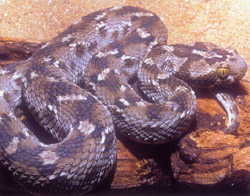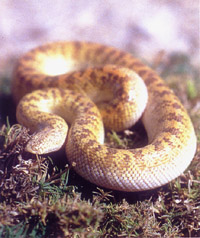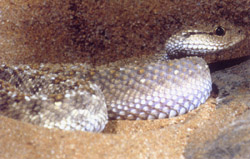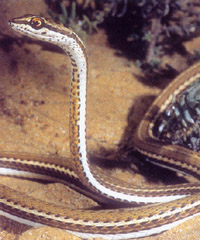A Slippery Customer
Snakes in the UAE
In our continuing series on Arabian Wildlife, Zac Sharpe takes a look at
the snakes found in the UAE and Arabian Gulf
 The snake is not a creature to breed apathy among humans.
The snake is not a creature to breed apathy among humans.
Depending on the culture of the region, the snake is either revered or
feared. Partly because of its strangeness of appearance and partly
because of its seemingly sly and secretive nature, the snake evokes
powerful emotions and associations.
Australian aborigines worship serpentine creatures which moved like
snakes to forge rivers and valley according to Dreamtime folklore. In
ancient Egypt the cobra or asp wasa sign of imperial power while
Cleopatra was said to have committed suicide by plunging her hand into a
basket of asps. Today the medical profession still uses the intertwined
snakes of the Greek cadeus as a symbol of healing.
It is hardly surprising that snakes are found widely on the Arabian
Peninsula and in the UAE in particular given they inhabit every
continent on earth with the notable exception of Antarctica.
But what is perhaps more unexpected is the sense of fear they arouse
among people living in the Gulf and the UAE. Unlike South America with
its 500 kilogram boa constrictors which can spectacularly subdue a
crocodile, North America with its famously intimidating rattlesnakes or
Australia with its poisonous dugites with a penchant for suburban
bushland, the snake breeds found in the UAE are generally quite benign
animals.
Much of this is probably attributable to the media which tends to pay
much more attention to the plight of more Ćattractive' local fauna, such
as the endangered Arabian oryx and Arabian leopard, or the nomadic feats
of the camel. Little is said of the rich variety of snakes which survive
in the emirates diverse but harsh environment. And even less effort is
directed at dispelling the myth of the snake as some kind of man-hunting
predator.
The Contenders and Pretenders
In reality many of the snakes found in the UAE are venomous. But the
target of their vitriol is more likely to be a mouse than a man.
The harmless snakes, such as the sand boa, blind snake, diadem snake and
thread snakes, have numerous short teeth solidly embedded in their jaws
and slightly curved to the rear of their mouth. There are no toxic
glands producing venom. The sole purpose of the teeth is to keep a solid
grip on its prey.
Some snakes, such as the cat snake found in the hills of the Musandam
Peninsula or the hooded malpon common in most low- lying scrub desert in
the region, are mildly venomous but still pose no threat to campers
taking flight from Dubai or Abu Dhabi.
These species will still bear teeth similar to those of the harmless
variety but in between they have one or several pairs of slightly longer
fangs with a groove. It is through these grooves the slightly toxic
venom trickles into wounds inflicted on the prey by the incisive teeth.
 These snakes are also called 'rear-fanged' since the fangs are located
at the rear of the mouth and usually only come into play when the
reptile has begun to swallow its victim. The reassuring fact for weekend
Bedouin to remember is that some of these animals can be highly toxic
but not the ones found on the Arabian Peninsula.
These snakes are also called 'rear-fanged' since the fangs are located
at the rear of the mouth and usually only come into play when the
reptile has begun to swallow its victim. The reassuring fact for weekend
Bedouin to remember is that some of these animals can be highly toxic
but not the ones found on the Arabian Peninsula.
While all snakes should be treated with caution to avoid possible
injury, the snakes which do present a genuine threat to the unwary
include the three species of carpet or saw-scaled viper, the nocturnal
horned viper and the mountain-dwelling Arabian cobra and false-horned
vipers.
The two groups of snake which present a threat to human safety are those
with long erectile fangs and those with short, curved fands in the front
of the upper jaw. Both have tubular fangs connected to poison-producing
glands through which toxin is inject by muscular compression of those
glands.
In the emirates, it is the vipers which bear the erectile fangs, their
teeth being so long they have evolved hinged making it possible for them
to fold back and prevent the snake injuring itself with its own weapon.
Locally, the only snakes which occur with short tubular fangs are the
sea snakes whose mouths are generally too small to inflict the wound
necessary to poison a human.
General Charcteristics
 Beneath their scaly skin, snakes have bones and muscles, heart and
intestines, liver and lungs much like those of other vertebrates. Most
of these organs have been modified however, for the snakes special mode
of life, in particular the habit of swallowing its prey whole and its
unique form of locomotion.
Beneath their scaly skin, snakes have bones and muscles, heart and
intestines, liver and lungs much like those of other vertebrates. Most
of these organs have been modified however, for the snakes special mode
of life, in particular the habit of swallowing its prey whole and its
unique form of locomotion.
Most species have more than 200 vertebrae connected to easc other by no
fewer than ten articulating surfaces, forming a strongly reinforced but
supple system which is moved by complicated sets of interlocking
muscles.
Many of the paired internal organs have either been reduced or offest
from one another to fit more easily within the slender frame. In fact
the primitive boas and pythons are the only snakes to retain a pair of
lungs. In most snakes the left lung is either absent or greatly reduced
while the kidneys have been repositioned with the left lying below the
right.
The UAE's hot climate ensures snakes will continue to exist here as long
as there environment is left undisturbed by human development and
encroachment.
Like most reptiles, snakes have a scaly skin which protects their body
and retains moisture in extreme high temperatures.Their absence from
genuinely cold countries can be attributed to their only serious
physical limitation - an inabilty to biologically regulate their own
internal body temperature. Most comfortable in a temperature range of
25-30 degrees Celsius,they are dependent on external heating and cooler
sources.
In the emirates, they are rarely troubled by the cold but must seek
shelter during summer months which can see the mercury soar into the
fifties during the day. For this reason many snakes common to the
region, such as Jayakar's sand boa and the awl-headed or leaf-nosed
snake, live a nocturnal existence rarely witnessed by man. Others
breeds, while not nocturnal, will restrict their activities to the early
morning or late afternoon.
It was once thought that snakes moved along the ground by 'walking on
their ribs', moving thwem back and forth like so many pairs of legs. It
is now known that the ribs remain still and the real 'walking' is
performed by movement of the enlarged ventral scutes that cover the
underbelly which overlap like tiles on a roof.
By moving these scutes in groups, with some pushing against the ground
while others slide forward, a snake can move slowly over the ground in a
straight line. But this form of travel is too slow for most breeds of
snake.
 The typical sand dwelling snakes of the UAE travel in probably the most
bewildering of all patterns of locomotion. Snakes such as the horned
viper make an arc with the front part of the body before 'throwing' its
head some distance before it touches the sand. The side-winding action
is created by the transference of the rest of its body across that arc
while laying out another arcwith its head. This motion has the advantage
of allowing the snake to progress across scorching, soft sand while
keeping its body largely off of the surface.
The typical sand dwelling snakes of the UAE travel in probably the most
bewildering of all patterns of locomotion. Snakes such as the horned
viper make an arc with the front part of the body before 'throwing' its
head some distance before it touches the sand. The side-winding action
is created by the transference of the rest of its body across that arc
while laying out another arcwith its head. This motion has the advantage
of allowing the snake to progress across scorching, soft sand while
keeping its body largely off of the surface.
One of the most graceful of snakes is also the longest found in the UAE.
The mildly toxic rear-fanged sand snake can grow to 155 centimetres in
length and moves with astonishing speed. Even in soft sand the sand
snake can propel itself in the regular sinuous way, since the
distribution of its body weight over a long, thin surface prevents it
from sinking and permits it to grip on the most unstable of surfaces.
Sneaking with a Forked Tongue
Although snakes usually possess the typical guides to the environment
such as vision and hearing these attributes are usually diminished if
not altogether absent.
Snakes compensate for such sensory deprivation with their tongues. The
reason behind the flicking out of the forked tongue has only been
deciphered relatively recently by scientists. Although an organ of
touch, the tongue functions primarily as a means of detecting chemical
signals in the air or on the ground. The highly developed tongue
collects the feintest traces of chemicals which are brought back into
the mouth. Here they are deposited in openings of the roof of the mouth
where an organ known as the Jacobson's organ analyses the chemical
signals. This helps explain why snakes such as the viper can trail their
prey in total darkness.
|
A Look at Snakes of the UAE and Arabian Gulf
Carpet or Saw Scaled Viper - The most dangerous snake in the UAE is the
Saw Scaled Viper, one of three such species found here. It lives a
nocturnal existence in the eastern Uae and the Musandam, south to
Masirah Island and central Oman. They are stocky with short tails,
hinged front fangs and pupils which contract to vertical cat-like slits
in bright light. They normally hide under rocks, litter or in rodent's
burrows by day and emerge at dusk to eat rodents, toads and other
reptiles.
Horned Viper - In the emirates, this beige-coloured snake is found in
all sandy deserts from the coast to the mountain plains. Entirely
nocturnal, it is brightly patterned, with a broad head, narrow neck,
robust body and short tail. It is not aggressive but like all vipers can
strike very quickly with its hinged front fangs if hunting or
intimidated.
Sand or Tree Snake - Mildly toxic but harmless to humans, it is
widespread in Arabia from Bahrain to Africa. Growing to a metre and a
half long, the sandy or olive-grey species is a good climber and is
active by day. Has bold black and white streaks from the snout along
along the sides of the head.. The belly is dark grey or golden.
Wadi Racer - Similar to the sand snake in appearance but only grows to
130 cm. With its long and slender body it can move at incredible speed.
Displays colour variations depending on habitat, although it cinfines
itself to the rocky areas of the UAE, preferably a wadi with running
water where it feeds on reptiles, small mammals and birds as well as
wadi fish which it can pursue in water. Has dark markings which become
indistinct toward the tail but completely lacks stripes on the head of
sand snakes.
Thread Snakes - One of the smallest snakes in the world with a build
synonymous with its name. It is bright pink or reddish with eyes visible
below smooth shiny scales. Shuns light and burrows for ants and termites
with its shovel-like snout. Found in sandy soil throughout the Arabian
Peninsula.
Sand Boa - It is hardly ever seen but is found in all the sandy deserts
of the UAE. It is nocturnal and spends almost all of its time under the
sand where it can glide without surfacing. Its eyes and nostrils, by
necessity, are on the top of its head, allowing it to lie in wait for
its prey. Typically it will then constrict the hapless food source
before swallowing it whole.
Blind Snake - Totally harmless, it is very common in Kuwait, east Saudi
Arabia, Bahrain, UAE and north Oman. Known as the gardener's friend, the
blind snake is spread in pot plants where it burrows into soft earth and
aerates the soil. Pink or brown, it does have eyes which are sunk below
smooth, shiny scales. Only surfaces at night.
Cat Snake - The smallest of the rear-fanged mildly toxic varieties found
locally, it bears a very large head with a distinct neck and slit-like
pupils which give it a viper-like appearance. A nocturnal creature, it
lives in the mountains and is absent from the open desert. An agile
climber, it searches birds nests and rock crevices for its sustenance.
Occurs in a range of colours, from reddish, to grey or brown. Probably
the rarest of the rear-fanged snakes in the area.
|